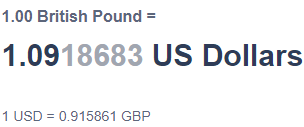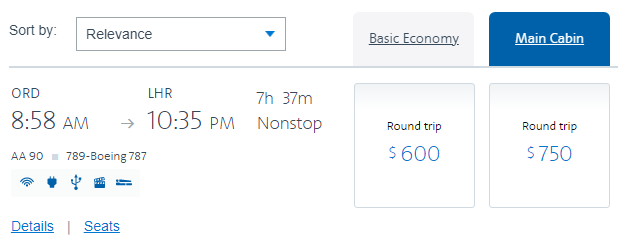UK Chancellor of the Exchequer (equivalent to the US Treasury Secretary) Kwasi Kwarteng (Cons.) announced significant tax cuts along with £72 billion in new spending to forestall higher energy bills this winter. Unfortunately, this massive stimulus comes during some of the highest inflation the UK has seen in a generation, estimated to be nearly 10% annualized as of this week.
Consequence? This, as of just a few minutes ago:

Sterling hasn't gone below $1.10 since 1985, and it probably won't again during my lifetime.
The Economist has no confidence in the scheme:
[Prime Minister Liz] Truss’s attempt to emulate the Gipper’s success is doomed. To see why, consider the currency markets. Reaganomics was accompanied by a strengthening dollar. So were Donald Trump’s tax cuts in 2018, which also happened alongside monetary tightening.
In Britain, though, the pound has slumped by 16% against the dollar in 2022.
As a result, the BOE will get no help from currency markets as it offsets Ms Truss’s fiscal stimulus with tighter monetary policy. Instead more expensive imports are boosting inflation. That is a big headache for an economy that depends on trade as much as Britain’s does.
Ms Truss’s cheerleaders seem to have read only the first chapter of the history of Reaganomics. The programme’s early record was mixed. The tax cuts did not stop a deep recession, yet by March 1984 annual inflation had risen back to 4.8% and America’s ten-year bond yield was over 12%, reflecting fears of another upward spiral in prices. Inflation was anchored only after Congress had raised taxes. By 1987 America’s budget, excluding interest payments, was nearly balanced. By 1993 Congress had raised taxes by almost as much as it had cut them in 1981. If Britain’s government does not correct its course in the same way, the result will be more conflict between monetary and fiscal policies—and a risk that inflation becomes entrenched.
On the other hand, lower costs in the UK combined with the usual slowdown in tourism across the Atlantic in autumn have made this possible on a 21-day advance purchase:

If only I weren't moving or performing in an opera in the next eight weeks, I'd buy a ticket to London right now.
I'm movin' out. A lovely young couple have offered to buy Inner Drive World Headquarters v5.0, and the rest of the place along with it. I've already gotten through the attorney-review period for IDTWHQ v6.0, so this means I'm now more likely than not to move house next month.
Which means I have even less time to read stuff like this:
Finally, American Airlines plans to get rid of its First Class offerings, replacing them with high-tech Business Class and more premium coach seats. I'd better use my miles soon.
Go hiking!
It’s not “purple mountains majesty” for hiking, Jason King knows, but Illinois, Indiana and southern Wisconsin, are not without charm — they’re free, they’re close, their trails are uncongested and they offer a solace and beauty all their own.
“I love Illinois, I’ve lived here all my life. If you like simplicity, if you like the feel of the wind blowing through the trees … there’s no place better,” King said.
One of King’s favorite solo hikes to “get the world behind me” is about 90 minutes away from Chicago near Gary, Indiana, in the little-used western part of Indiana Dunes National Park. The Paul H. Douglas center is currently closed but the namesake trail (1) winds through Miller Woods and across the Grand Calumet River. It was named after the Illinois senator who helped make the Dunes a national park. It’s a moderately challenging 3.5 miles out and back, partly through sand dunes — which make it a workout.
King identified 19 other trails near Chicago that reporter Zachary Nauth listed in the article. Maybe next weekend? Cassie would probably love all of them.
Wired examines the art and science of managing an 8-kilometer, 14-hour queue:
At its peak, the queue has snaked 5 miles across the capital, with an estimated 14-hour wait. When it reached capacity and closed on Friday, people defied government advice and formed a separate queue for the queue. Such scenes are remarkable—but they’re not unprecedented. When George VI—Queen Elizabeth II’s father—died in February 1952, 300,000 people filed past his coffin in St. George’s Chapel over the course of three days.
Up to 750,000 people are expected to see the queen over the course of her lying in state. At any one time, 30,000 to 40,000 people could be standing in line, according to crowd safety consultant Andy Hollinson, who worked on other aspects of the plan to honor the queen after her death, called Operation London Bridge, but who was not involved in the lying-in-state element. Such estimates are conservative and based on an orderly queue in which people are standing three abreast. The queue in London is more of an orderly blob than a line. “Nobody’s ever seen a queue as long as this before,” says Hollinson.
But despite the unprecedented nature of the queue, prep work has been ongoing for years. “I can see a lot of similarities with the plans I developed 10 years ago,” says Keith Still, visiting professor in crowd science at the University of Suffolk, who, in 2011, was among those asked by London’s Royal Parks to develop a queueing and security screening system for events like a royal funeral. “Wherever the bottleneck is, you work back from that,” says Still. That, in this instance, is the security screening area at the entry to Westminster Hall.
I cannot think of a single reason I would voluntarily stand in a 14-hour queue. But hey, I've never lost a beloved monarch.
I love this, but I have to ask: why did the Post do this, and not the Tribune or Block Club Chicago?
As an adopted Chicagoan and longtime John Hughes devotee, I’ve always wondered whether it’s possible to do everything Ferris accomplished as he dodges school in the 1986 film. He knocks out a trip to the top of the Sears Tower, the Chicago Board of Trade, a fancy French lunch, a Cubs game, the Art Institute, the Von Steuben Day parade and the beach, then races on foot through his North Shore suburb to get home by 6 p.m. Even with the help of movie magic, it seems like a stretch.
Given real-life time constraints and logistics, we had to make tweaks to fit every activity. First, it’s nearly impossible to find a parade and a home game for the Cubs on a weekday, but on Saturday, Sept. 10, we found both a game and the actual parade from the movie.
Just because Ferris never looks rushed in the movie doesn’t mean this is a leisurely day. If you want to see everything on his list, you’ve got to keep up the pace. At the same time, you should remember to take a minute to appreciate what you’re experiencing. After all, as our hooky-playing hero says: “Life moves pretty fast. If you don’t stop and look around once in a while, you could miss it.”
Too bad they didn't have a Ferrari.
I do love traveling Saturday mid-days, because it's the quietest time at O'Hare. There was no line at the Pre-Check security gate, and I only have a backpack, so it took less than 3 minutes to clear TSA. Wonderful.
Unfortunately, every single economy parking space has a car in it. (I would have taken public transit but I had a meeting run until 12:30, with a 3pm flight. Couldn't risk the 90 minutes or so.)
In any event, my plane is here, it appears to be on time, and the latest weather is VFR the whole way. Next report from North Carolina.
I'm heading to North Carolina this afternoon, so I probably won't post much this weekend. The forecast for Durham looks even better than for Chicago. I had hoped to (finally!) take in a Bulls game tomorrow, but it appears they will be in Gwinnett, Ga., which is a bit of a drive.
It happens every September in the mid-latitudes: one day you've got over 13 hours of daylight and sunsets around 7:30, and two weeks later you wake up in twilight and the sun sets before dinnertime. In fact, Chicago loses 50 minutes of evening daylight and an hour-twenty overall from the 1st to the 30th. We get it all back in March, though. Can't wait.
Speaking of waiting:
Finally, Fareed Zakaria visited Kyiv, Ukraine, to learn the secret of the country's success against Russia.
The President announced this morning that negotiators have reached a tentative deal between the railroads and their engineers and conductors, averting tonight's planned strike:
Freight rail companies and unions representing tens of thousands of workers reached a tentative agreement to avoid what would have been an economically damaging strike, after all-night talks brokered by Labor Secretary Martin J. Walsh, President Biden said early Thursday morning.
The agreement now heads to union members for a ratification vote, which is a standard procedure in labor talks. While the vote is tallied, workers have agreed not to strike.
The talks brokered by Mr. Walsh began Wednesday morning and lasted 20 hours. Mr. Biden called in around 9 p.m. Wednesday, a person familiar with the talks said, and he hailed the deal on Thursday in a long statement.
“Most importantly, for the first time ever, the agreement provides our members with the ability to take time away from work to attend routine and preventative medical, as well as exemptions from attendance policies for hospitalizations and surgical procedures,” the presidents of the Brotherhood of Locomotive Engineers and Trainmen and the Transportation Division of the International Association of Sheet Metal, Air, Rail and Transportation Workers said in a news release.
Excellent news for the unions! And for us travelers, and for us consumers. Whew.
Chicago's heavy-rail commuter district, Metra, started cancelling train service that would extend past the midnight-Friday start time of the planned nationwide rail strike. Well, taking the El to work instead of Metra adds about 9 minutes to my commute, so I'll have to deal with that on Friday, I suppose. Except that commuter rail shutdowns don't even start to illustrate how bad this strike could turn out for the US economy:
[A strike] would cause immediate problems for manufacturers, says Lee Sanders with the American Bakers Association. This is nationwide. And a broad range of manufacturers who get parts, packaging and raw material delivered by rail would be effected.
"If we don't get the ingredients that we need to our plants, we won't be able to make the products that we need to get our wholesome products to the consumers," Sanders says.
So, empty shelves are a possibility. Farmers are worried too about shipping grain. Dangerous chemicals have already stopped moving. Especially valuable goods are next, and passengers are getting stranded too.
Don't forget about coal, either. About 22% of US electricity comes from coal-fired plants, including 30% of Illinois' power. (As it turns out, Illinois has a higher proportion of nuclear power—about 54% of output—than any other state, which gives us a bit more reliability.)
I have a lot of sympathy for the engineers and conductors, whose schedules seem even less predictable than even fast-food workers. I hope the railroads agree to better scheduling and time-off provisions before Friday, or we're going to have a major economic disruption while we already have high inflation. Not a good combination.